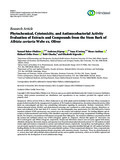| dc.contributor.author | Obakiro, Samuel Baker | |
| dc.contributor.author | Kiprop, Ambrose | |
| dc.contributor.author | K’owino, Isaac | |
| dc.contributor.author | Andima, Moses | |
| dc.contributor.author | Owor, Richard Oriko | |
| dc.contributor.author | Chacha, Robi | |
| dc.contributor.author | Kigondu, Elizabeth | |
| dc.date.accessioned | 2023-12-08T07:47:51Z | |
| dc.date.available | 2023-12-08T07:47:51Z | |
| dc.date.issued | 2022-01-22 | |
| dc.identifier.uri | https://doi.org/10.1155/2022/7148511 | |
| dc.identifier.uri | https://www.hindawi.com/journals/ecam/2022/7148511/ | |
| dc.identifier.uri | http://ir-library.mmust.ac.ke:8080/xmlui/handle/123456789/2480 | |
| dc.description.abstract | ackground. Albizia coriaria Welw ex. Oliver (Fabaceae) is one of the plants used by herbalists in the East Africa community to prepare herbal remedies for the management of symptoms of TB. Despite its widespread use, the antimycobacterial activity of this plant was uninvestigated and there was contradicting information regarding its cytotoxicity. Methods. Cytotoxicity (MTT), antimycobacterial activity (MABA), and phytochemical screening were conducted on crude extracts (hexane, chloroform, acetone, and methanol) of the stem bark of A. coriaria. Gas chromatography-mass spectrometry (GC-MS) followed by Fourier transform infrared (FTIR) spectroscopy was carried out on the acetone and methanol extracts. The binding affinities and descriptors of pharmacokinetics and toxicity of the identified compounds were predicted using computational modelling software. Results. The cytotoxic concentrations of all extracts were greater than 1000 μg/mL. The minimum inhibitory concentration of both the acetone and methanol extracts was 1250.0 ± 0.0 μg/mL against M. smegmatis, whereas that against M. tuberculosis was 937.0 ± 442.0 μg/mL and 2500.0 ± 0.0 μg/mL, respectively. Hexane and chloroform extracts were not active against both strains. Alkaloids, triterpenes, flavonoids, tannins, and saponins were the predominant phytochemicals present. GC-MS analysis revealed twenty-eight and nineteen compounds in acetone and methanol extracts, respectively. Among these was hydroquinone, which was previously reported to possess antimycobacterial activity. Seven compounds identified through GC-MS analysis had better binding affinities for the mycobacterial ATPase and polyketide synthase-13 than isoniazid and rifampicin. These compounds also showed variable but promising pharmacokinetic properties with minimum toxicity. Conclusion. There are phytochemicals in A. coriaria stem bark with potential antimycobacterial activity and acceptable cytotoxicity, which can be further explored and optimized for the development of novel antitubercular drugs. | en_US |
| dc.language.iso | en | en_US |
| dc.publisher | Evidence-Based Complementary and Alternative Medicine | en_US |
| dc.subject | Phytochemical, Cytotoxicity, Antimycobacterial, Activity, Evaluation, Extracts, Compounds, Stem, Bark, Albizia coriaria ,Welw ex. Oliver | en_US |
| dc.title | Phytochemical, Cytotoxicity, and Antimycobacterial Activity Evaluation of Extracts and Compounds from the Stem Bark of Albizia coriaria Welw ex. Oliver | en_US |
| dc.type | Article | en_US |

